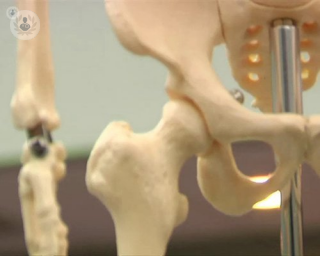Osteomyelitis
Professor Nima Heidari - Orthopaedic surgery
Created on: 02-11-2014
Updated on: 09-26-2023
Edited by: Kate Forristal
What is osteomyelitis?
Osteomyelitis is an infection of the bone, affecting between 10 and 100 people per 100,000 each year .
Bones can be infected in a number of ways: after surgery, from a fracture, or from a wound. It is also possible for an infection in the blood to affect the bone. Your risk of a bone infection is increased if you have had hip surgery, have a weakened immune system, or have diabetes.
Osteomyelitis can affect both children and adults. In children, it is more common to have acute osteomyelitis, which develops rapidly over a period of seven to 10 days. In adults, especially people with diabetes, it is more common to have chronic osteomyelitis.

Prognosis
Most cases of osteomyelitis are treatable, particularly acute osteomyelitis. In the case of chronic osteomyelitis, however, the infection can come back multiple times, and treatment may need to be more aggressive (see below). The faster osteomyelitis is diagnosed and treated, the more likely it is to clear up completely.
Symptoms of osteomyelitis
It typically results in inflammation, pain, and other symptoms. The specific symptoms can vary depending on the individual, the affected bone, and the severity of the infection. Common symptoms of osteomyelitis may include:
Pain: Persistent and often severe pain in the affected bone is one of the hallmark symptoms of osteomyelitis. The pain may worsen with movement or when pressure is applied to the area.
Swelling: The infected area may become swollen and tender. Swelling can be localised to the infected bone.
Redness and warmth: The skin over the infected area may appear red and feel warm to the touch due to inflammation.
Fever: A fever is a common systemic symptom of infection, including osteomyelitis. A high body temperature may indicate a more severe infection.
Chills: Some individuals with osteomyelitis may experience chills, which often accompany fever.
Fatigue: In more advanced or severe cases, the body's response to the infection can lead to fatigue and weakness.
Limited range of motion: If a joint is affected, there may be a limited range of motion in that joint due to pain and swelling.
Drainage from the skin: In chronic or long-standing cases, an abscess (collection of pus) may form near the infected bone, and this abscess can sometimes rupture through the skin, leading to drainage or pus.
Weight loss: In severe cases, especially if the infection is not properly treated, weight loss can occur due to the body's efforts to fight the infection.
Bone deformity: In some cases, chronic osteomyelitis can lead to bone deformity or the development of sequestrum (dead fragments of bone) within the affected area.
How is osteomyelitis diagnosed?
When you visit the GP they will perform a physical exam of the affected area. They might order scans, such as an X-ray or MRI, to see the infection more clearly, and blood tests to determine the kind of infection it is. In some cases, the GP might recommend a bone biopsy to confirm the diagnosis.
Can it be prevented?
You can help prevent osteomyelitis by keeping any wounds or cut clean to stop infection. This means thoroughly washing a wound for several minutes then using sterile bandages.
If you have diabetes it’s important to regularly check your feet for signs of cuts or bruises, and see the GP as soon as you notice any infection.
How is it treated?
Treatment primarily involves the use of antibiotics to fight the infection. Antibiotics will usually be delivered by IV, so it is likely you will have to stay in hospital until you can take antibiotic tablets instead.
Sometimes surgery is considered if you have an abscess in the bone or the infection is pressing against something else. You may also need surgery if the bone has been damaged and needs to be removed, or if antibiotics have not been effective against the infection.






